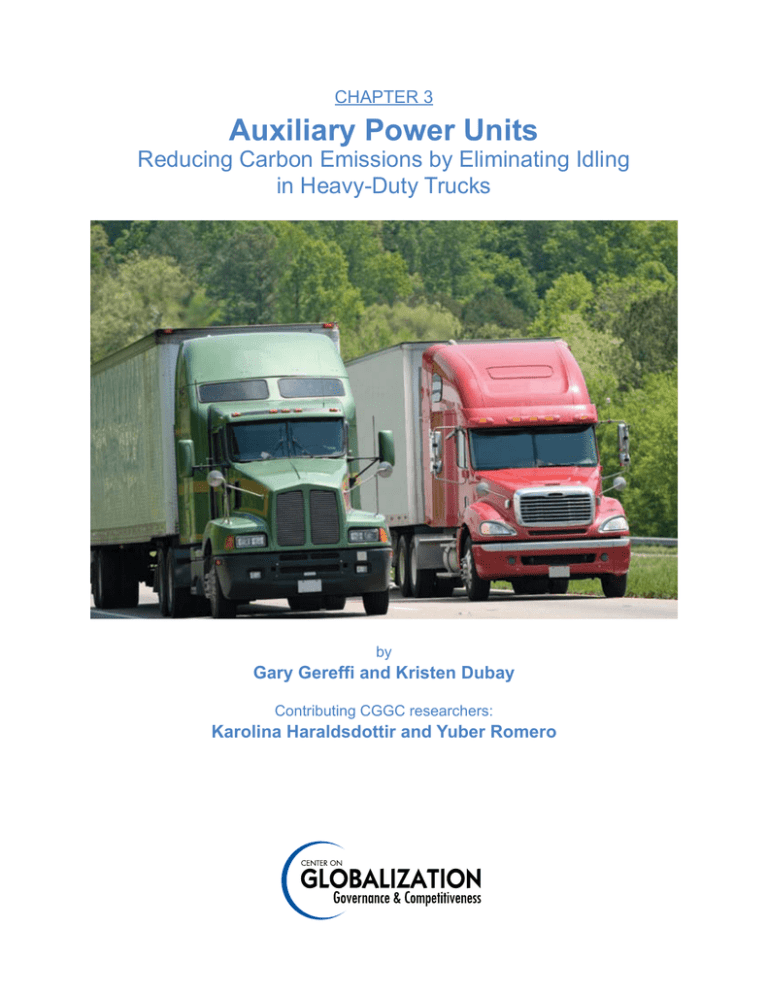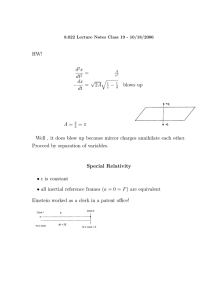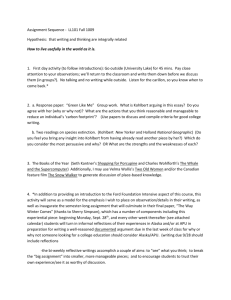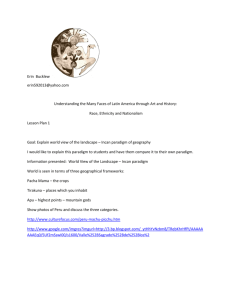Auxiliary Power Units
advertisement

Chapter 3 Auxiliary Power Units Reducing Carbon Emissions by Eliminating Idling in Heavy-Duty Trucks by Gary Gereffi and Kristen Dubay Contributing CGGC researchers: Karolina Haraldsdottir and Yuber Romero Summary The auxiliary power unit (APU) offers long-haul truck drivers amenities like air conditioning during driving breaks while eliminating the need to idle the engine. This technology could help eliminate 11 million tons of carbon dioxide emissions from truck idling in the United States each year (SmartWay Transportation Partnership, 2004). The market penetration for APUs in the United States is about 5% (Bubbosh, 2008). Thus, APU technology has significant potential to reduce future carbon emissions, and it constitutes one of the U.S. Environmental Protection Agency (EPA) SmartWay Transport Partnership strategies. In addition to environmental benefits, current APUs save on average 8% in fuel costs each year, according to the EPA. High upfront costs (approximately $7,000-$9,000 per unit) limit APU penetration. To assist with the expansion of idle reduction technologies, the EPA has partnered with the Small Business Administration to set up attractive loan packages for trucking companies that implement SmartWay strategies, such as the use of APUs. Expanded production of APUs would create economic opportunity at all stages of the value chain by increasing purchases from material and component suppliers, many of which are U.S.based. A secondary economic impact of expanded APU production and sales could be increased demand for APU installation and service providers across the country. Additional value chain opportunities will likely come when APU technology is integrated as a component in tractor manufacturing rather than being an aftermarket product. If this occurs, APU manufacturers will become component suppliers to tractor manufacturers instead of to retailers who sell to end users. This would likely realign the supply of jobs along the value chain, with more emphasis on manufacturing and service work and away from retail and installation jobs. It is possible that vertical integration could reduce the cost barriers of adding APUs as an aftermarket product. Thus, these changes could have positive U.S. job implications if they result in more widespread use of APUs on tractors, which would require increased production and a greater need for APU service work. Figure 3-1. Auxiliary Power Unit ALTERNATOR ENGINE AIR FILTER A/C COMPRESSOR EXHAUST GENERATOR BELT TENSIONER Reprinted with permission from Black Rock Systems, http://www.blackrockapu.com 38 Introduction There are five major types of idling reduction technologies: cab and block heaters, automatic engine start-stop controls, battery-powered air conditioning systems, on-and-off truck electrification, and auxiliary power units. While not the most commonly used idling reduction technology, APUs enable truck drivers to access the full range of cabin comforts (e.g., heating, air conditioning, electricity for personal devices such as televisions and cooking devices) without restricting where the truck must stop. Other idle reduction technologies either dictate stopping locations or provide fewer amenities. The current market penetration rate for all idle reduction technologies is estimated at 36% of the sleeper cab market (American Transportation Research Institute, 2006). Approximately 12% of drivers with idle reduction technologies are estimated to use APUs. Fuel-operated heaters, which provide heat to the cabin when the engine is off, are more common, with a penetration rate of approximately 32% of that population (American Transportation Research Institute, 2006). Fueloperated heaters do not offer the full range of cabin comforts provided by an APU, but their penetration rate is higher because of the lower up-front costs. The low penetration of APUs indicates untapped manufacturing and sales potential for this market, but it also illustrates the difficulty in convincing fleet owners and independent truck owner-operators to purchase and install APUs. Some barriers include the high initial costs and lack of awareness of true idling costs. These may be overcome by rising fuel prices. Other barriers include a 12% federal excise tax and APU system durability concerns (Bubbosh, 2008; Lutsey et al., 2003). However, there is an effort to address the excise tax, and a survey by the American Transportation Research Institute found that, in general, drivers are satisfied with system performance and indicate the high initial investment to be the major deterrent (American Transportation Research Institute, 2006). Auxiliary Power Unit Value Chain The auxiliary power unit has more than 43 components, and the value chain incorporates five stages: materials, components, finished product, distribution (including installation and technical support), and end use. Figure 3-2 illustrates this value chain, and a more complete value chain with illustrative company information appears at the end of the chapter. Many of the companies involved across the APU value chain are located in the United States. Expanded production of APUs could create economic opportunity at all stages of the value chain. Materials The major raw materials used in APU component manufacturing are aluminum, copper, plastic, steel, zinc, brass, and fiberglass. Other raw materials include cotton gauze, carbon, and filter cloth. The United States is the world’s largest producer of plastic and brass (United Nations Industrial Development Organization, 2007 and NBMmetals.com, 2007). The top U.S. producing companies are Dow Chemical Company and E.I. du Pont De Nemours & Company for plastics, and National Bronze & Metals and Allied Brass for brass (Hoover’s Inc., 2008b, 2008c; and NBMmetals.com, 2007). The United States also supplies a significant portion of the other raw materials with the exception of zinc. The major producers for iron ore and steel are Cleveland Cliffs and U.S. Steel (Cleveland Cliffs, 2008; U.S. Steel, 2008), and the major producers of aluminum are Alcoa, Inc. and A.M. Castle (Hoover’s Inc., 2008a). The market strength of and proximity between suppliers of raw materials and U.S. components and APU manufacturers is an opportunity to strengthen domestic job opportunities within the value chain. 39 Figure 3-2. Simplified Auxiliary Power Unit Value Chain Materials Components Diesel engine Steel Aluminum Copper Other components Batteries for hybrid or electric APU Plastic Top APU manufacturers HVAC unit Alternator Zinc coated plates Finished Product Other APU assemblers Truck manufacturing companies incorporating APUs Distribution Dealers End Use Trucking and freight companies Wholesalers Independent truck drivers Installation and technical support Truck manufacturing companies (OEMs) Brass Carbon Cotton gauze Fiberglass Filter cloth R&D There are a few manufacturers and small developers designing new fuel, hybrid, and all-electric APUs Source: CGGC, based on company annual reports, individual interviews, and company websites. Components Diesel APUs have three major components: the alternator; the engine (usually 2- or 3-cylinder); and the heating, ventilating, and air conditioning (HVAC) system. The main components of the alternator include the bearings, brushes, housing, rectifier, regulator, rotor, and stator. The main components of the diesel engine include the integrated rotor, stator generator, block, bearings, and cylinder. The main HVAC system components include the compressor, refrigerant, evaporator, and condenser. The major suppliers of engines and HVAC systems are listed in Table 3-1. Many APU engines are manufactured outside the United States, but company interviews indicate that a significant proportion of other component manufacturing and assembly is completed here. For example, the Thermo King TriPac APU has a Yanmar engine made in Japan, but enough of the remaining APU manufacturing and assembly is done in the United States that the APU meets classification as a U.S.-made product (Kampf, 2008). 40 Relatively new to the market are hybrid and electric APUs, for which batteries and an inverted charger are important components in the value chain. The components of an all-electric APU are the HVAC system, batteries, the alternator, and an inverted charger. Table 3-1. Illustrative APU Engine and HVAC System Manufacturers APU Component(s) Manufacturer Engine Isuzu Engine Kubota Engine Perkins Engine Yanmar Engine & HVAC system Caterpillar Engine & HVAC system Cummins HVAC system Dometic Environmental Corp. HVAC system Mobile Thermosystems HVAC system Thermo King Location Japan Japan & Illinois Japan & Georgia Japan Illinois Indiana Virginia Canada Minnesota Source: CGGC, based on company annual reports, individual interviews, and company websites. APU Manufacturing Thermo King is the leading manufacturer of APUs with more than 50% of APU sales (Kampf, 2008). Other market leaders include Rigmaster Power (15%-20% market share), Black Rock Systems (10%), and Teleflex (which sells its APU through Carrier Transicold retailers). A number of other companies offer APUs, but these smaller companies often focus on assembly rather than component innovation, and they outsource the manufacturing of parts. The smaller APU companies have limited market share and move frequently into and out of the APU market. A more inclusive list of APU manufacturing companies and their headquarter cities and states appears in Table 3-2. The APU manufacturing companies have a broad geographic distribution across the United States (see Figure 3-4). The majority are small companies with fewer than 100 employees. The smallest firms have limited distribution networks and operate in local markets selling and installing the APUs on location. By contrast, the big companies have multi-state distribution, installation, and service networks. Three of the most common APUs on the market are the TriPac (Thermo King Co.), the RigMaster Power (RigMaster Power, Inc.), and the Black Rock (Black Rock Systems) (Bosch, 2008; Landstar System, Inc., 2008). 41 Figure 3-3. Auxiliary Power Unit Materials and Corresponding Components Components Materials Alternator Steel - Bearings - Brushes - Housing - Rectifier - Regulator - Rotor - Stator Plastic Copper Diesel engine - Bearings - Block - Cylinder - Cylinder wall - Integrated rotor - Motor home - Oil pumping - Piston - Stator generator Aluminum Cotton gauze HVAC unit - Air filter - Aluminum housing - Compressor - Condenser - Copper pipe - Contactor - Dehumidifier - Electric engine - Evaporator - Fan - Heat pump - Radiator - Thermostats - Refrigerant - Wiring Carbon Filter cloth Brass Zinc coated plates Other components Fiberglass - APU cover - Battery charger - Belt transmission - Converter - Electronic control modules - Filters, air and oil - Generator - APU mount - Muffler - Radiator - Receptacles - Wiring Source: CGGC, based on company annual reports, individual interviews, and company websites. 42 Table 3-2. Auxiliary Power Unit Manufacturers, 2007 Company Auxiliary Power Dynamics, LLC Black Rock Systems, LLC* Comfort Master Cummins Daimler Trucks North America, LLC Double Eagle Industries Enertek Corporation Florida Manufacturing Group Flying J, Inc. Kohler Power Systems (Mobile Div.) Pony Pack, Inc. Rigmaster Power, Inc.* SCS/Frigette Corporation Star Class, Inc. Teleflex Power Systems* Temco Metal Products* Thermo King Company* Tridako Energy Systems APU Name Willis Auxiliary Power System Black Rock; Black Rock Evolution Comfort Master ComfortGuard System NITE anti-idling system; RestSmart system GenPac Infini-Gen IdleBuster Cab Comfort System Headquarters Sparks, NV Reno, NV Whittier, CA Minneapolis, MN Kohler 3APU; Kohler 7APU Kohler, WI Pony Pack RigMaster Power Alliance APU Gen-Star ComfortPro Idle Solutions APU TriPac PowerCube Albuquerque, NM Olathe, KS Fort Worth, TX New Castle, PA Canada Clackamas, OR Bloomington, MN Alliance, NE Portland, OR Shipshewana, IN Beaverton, OR Odessa, FL Ogden, UT *Indicates top APU manufacturing companies Source: CGGC, based on company annual reports, individual interviews, and company websites. Some heavy-duty truck manufacturers also play a role in manufacturing idling reduction technologies like APUs. For example, Daimler Trucks North America owns Alliance Parts, which manufactures the Alliance APU. The Alliance APU is installed in Daimler trucks and also commercialized in the market. Navistar installs Maxxpower APUs in some of its trucks, and Mack Trucks, Inc. is another company installing APU technology. The fact that truck manufacturers are investing in these technologies indicates recognition of the demand for idling reduction by fleet and independent truck owners. In fact, this demand seems to be increasing, and APU technology appears to be going in the direction of vertical integration, with factory installation of APUs becoming more common than after-market sales. 43 Figure 3-4. Geographic Distribution of U.S. Companies Manufacturing Auxiliary Power Units and Engine and HVAC System Components WA MT OR ME ND VT MN ID WI SD WY NV NE PA IN CO KS AZ MI IA UT CA NY MO OK NM KY VA MA RI CT NJ DE MD NC TN SC AR LA APU Manufacturers WV IL MS TX OH NH AL GA FL U.S. APU Manufacturers U.S. APU Engine Manufacturers U.S. APU HVAC Manufacturers Source: CGGC, based on company annual reports, individual interviews, and company websites. Distribution Over 2,300 companies across the country provide APU retail, installation, and maintenance services. Most of these vendors are dealers, service centers, and installation centers. These vendors are generally small businesses with fewer than 30 employees. The APU dealer/retail network is well distributed across the country, with a minimum of six in the District of Columbia and a maximum of 129 in Texas. Many of these actors in the value chain employ workers with mechanical skills. Greater APU use in long-haul trucks has the potential to increase the need for service jobs nationwide. End Use The final stage of the value chain refers to consumers of APU technologies, including freight companies, independent truck drivers, and truck manufacturing companies. There are about 41,000 general freight trucking companies in the United States. Approximately 5% are large companies with more than 100 drivers; 37% have between four and 100 drivers; and 60% have fewer than four drivers (U.S. Bureau of Labor Statistics, 2008b). Larger companies who own the tractors and trailers may be more likely to see the value of idling reduction technologies and have the resources to install them (Plunkett Research Online, 2008a). There also are about 330,000 tractor truck owner-operators throughout the United States (Truck Info Net, 2008). Many of these individuals would like to have an APU for cost savings but are resistant to the high upfront capital costs. Trucking companies and independent truck owners are less likely to install APUs 44 on trucks that are more than three years old, so the potential market for APUs is generally limited to Class A sleeper cabs less than four years old (Kampf, 2008). Total revenues for the truck transportation sector were $219 billion in 2006, and expenses exceeded $201 billion (Plunkett Research Online, 2008a). The industry’s relatively small profit margin of 8% in 2006 makes it a prime candidate for idling reduction technologies that lower fuel and maintenance costs (Plunkett Research Online, 2008b). Furthermore, the U.S. Department of Labor predicts the truck transportation sector will grow its total revenues by 11.1% by 2016, generating 160,000 new jobs (U.S. Bureau of Labor Statistics, 2008a). Such growth indicates potential for greater demand for APUs and other idling reduction technologies, which will help reduce long-haul truck fuel needs. Case Study: Wal-Mart Adopts APUs In 2005, Wal-Mart introduced a goal of doubling the efficiency of its trucking fleet by 2015. Wal-Mart has the second largest private fleet in the nation. Increasing fleet efficiency to this level will prevent 13 million tons of carbon dioxide emissions (Addison, 2007). One of Wal-Mart’s first steps towards this goal was to purchase and install 7,000 APUs in its long-haul trucks. The company has estimated APUs save $25 million in annual fuel costs, a figure that has likely increased with higher global oil prices in 2007 and 2008 (Addison, 2007). Furthermore, Wal-Mart’s 2007 model truck includes an APU and other improvements, such as trailer side skirts, super single tires, an aerodynamic tractor package, and a tag axle (Green Car Congress, 2005). Wal-Mart estimated these changes will save the company $52 million per year in fuel costs. For the future, the company is also evaluating various hybrid technologies, such as those by Peterbilt and Eaton, for a new class-8 heavy-duty vehicle (Addison, 2007). Case Study: Enertek Solutions Creates an Efficient Battery-Powered APU As more fleet owners recognize the unique opportunity to simultaneously reduce costs and present a more sustainable company image, the market for APUs could expand significantly. Specific APU technology improvements, such as widespread development of hybrid APUs, more efficient battery-powered APUs, and further research and development of other types of APUs, may play an important role in increasing the technology’s appeal. Enertek Solutions, Inc., out of Portland, Oregon, introduced the Infini-Gen, an all-electric APU, in March 2008. The APU has no engine because it runs on battery power of any kind, including advanced battery technology such as nickel-metal hydride and lithium ion rechargeable batteries. The batteries are high-powered and make the APU lighter than previous diesel and batterypowered models. Furthermore, the system recharges while the truck engine is running, and it also can be plugged into external power sources (shore power). The Infini-Gen requires only six hours to install (compared to about 24 hours for diesel APUs), and the total cost including installation is $7,500. Enertek Solutions has a commitment of 1,000 Infini-Gen APUs to a large Carrier Transicold dealer and is in licensing discussions with several companies in North America and Europe including Paccar (Baumann, 2008). 45 Figure 3-5. Hybrid and All-Electric Infini-Gen Images reprinted with permission from Enertek Corporation, http://www.enerteksolutions.com/. Other technological advances include efforts by BMW and Boeing to develop solid oxide fuel cell technologies that would allow for lighter and smaller engines. As this technology is refined and its cost structure is reduced, solid oxide fuel cells could be incorporated into long-haul truck APUs. Conclusion It appears likely that idling reduction technologies will soon be incorporated into truck engine manufacturing by original equipment manufacturers. Whether or not APUs or other types of idle reduction technologies are incorporated remains unclear, although Daimler, Kenworth, and Peterbilt, among others, have adopted factory-installed APUs on some Class A sleeper cabs. Integrating idling reduction into long-haul truck manufacturing could help further reduce carbon emissions and may overcome some of the cost barriers associated with adding APUs or other idling reduction technologies as aftermarket add-ons. On the other hand, integration into truck manufacturing also could impact additional job opportunities at the manufacturing and installation stages of the value chain because this work may be subsumed by existing jobs. Nonetheless, there are clearly opportunities to reduce truck idling among existing long-haul trucks through expanding the available fuel-powered APUs and supporting opportunities to develop and manufacture new hybrid and electric APUs and other idling reduction technologies. Furthermore, vertically integrating APUs as components in the tractor truck manufacturing system offers the potential to dramatically expand use of APUs. Such an expansion, in addition to the expected growth in the trucking industry, could have positive job implications at the material, component, and manufacturing stages of the value chain as well as increased demand for service and maintenance jobs. 46 Figure 3-6. Auxiliary Power Unit Value Chain, with Illustrative Companies Materials Steel (China, Japan, U.S., Russia) Top U.S. producers: Cleveland Cliffs U.S. Steel Aluminum (China, Russia, Canada, U.S.) Top U.S. producers: Alcoa, Inc A.M. Castle Zinc coated plates (China, Canada, Spain, Australia) Copper (Chile, U.S., Indonesia, Peru) Top U.S. producers located in AZ, UT, NM, NV, MT Components Finished Product Diesel Engine Companies Top APU Manufacturers -Caterpillar (IL) -Cummins (IN) - Isuzu (Japan) - Kubota (IL) -Perkins (Japan & GA) -Yanmar (Japan) -Black Rock Systems (NV) -Rigmaster Power (KS) -Teleflex Power Systems (Canada) - Thermo King (MN) HVAC Unit Companies - Caterpillar (IL) - Cummins (IN) - Dometic Environmental Corp (VA) - Mobile Thermosystems (Canada) -ThermoKing (MN) Alternator Plastic Other (U.S., Germany, France, China) Top U.S. producers: Dow Chemical Company E.I. du Pont de Nemours & Co Components Batteries for Hybrid or Electric APU Other APU Manufacturers and Assemblers - Auxiliary Power Dynamics (NV) -Comfort Master (CA) - Cummins (IN) - Double Eagle Industries (IN) -Enertek (OR) -Florida Manufacturing Group (FL) -Flying J ( UT) - Kohler Power Systems (WI) -Pony Pack (NM) - SCS/Frigette (TX) - Star Class (PA) -Temco Metal Products (OR) - Tridako Energy Systems (NE) - Electro Energy (CT ) Brass (China, U.S., Germany, Japan, Italy) Top U.S. producers: National Bronze & Metals, Allied Brass Carbon Cotton gauze Distribution End Use Dealers, Wholesalers, Installation and Technical Support Trucking and Freight Companies Over 2322 companies across United States Most are small business with 30 or fewer employees. Texas, California, and Pennsylvania each have about 5% of the network # Dealers and service centers across the US, by company: Daimler - 721 Flying J Inc. - 429 Cummins - 255 ThermoKing - 187 Power Technology - 170 Rig Master Power - 159 Kohler Power Systems - 82 Black Rock Systems - 53 Carrier Transicold - 48 Auxiliary Power Dynamics - 20 Comfort Master - 19 Truck Manufacturing Companies Incorporating APUs -Con-way (CA) -Plains All American Pipeline (TX) -Ryder System (FL) -Schneider National (WI) -Swift Transportation (AZ) Independent Truck Drivers Approximately 330,000 owner/ operators Truck Manufacturing Companies (OEMs) -Mack Trucks, Inc. (PA) -Navistar (International & IL) -Paccar / Kenworth (WA) -Peterbilt (TX) -Volvo Trucks North America (NC) -Daimler Trucks North America (OR) -Mack Trucks, Inc. (PA) -Navistar (International and IL) Fiberglass Filter cloth R&D There are a few manufacturers and small developers designing new fuel, hybrid, and all-electric APUs. Source: CGGC, based on company annual reports, individual interviews, and company websites. 47 References Addison, John. (2007). Wal-Mart to Save $300 Million with Hybrids. Retrieved May 22, 2008, from http://www.cleanfleetreport.com/fleets/walmart.htm American Transportation Research Institute. (2006). Idle Reduction Technology: Fleet Preferences Survey. Alexandria, VA. Baumann, Paul. (2008). Co-Principal, Enertek Corporation. Personal communication with CGGC Staff. May 29. Bosch, Ron. (2008). Marketing Personnel, Temco Metal Products. Personal communication with CGGC Staff. September 30. Bubbosh, Paul. (2008). EPA Headquarters staff, SmartWay Transportation Partnership. Personal communication with CGGC Staff. May 20. Cleveland Cliffs. (2008). Operations. Retrieved May 26, 2008, from http://www.clevelandcliffs.com/Operations/NAIO/Pages/NorthAmericanIronOre.aspx Green Car Congress. (2005). Wal-Mart Seeks to Double Truck Fuel Economy by 2015. Retrieved May 22, 2008, from http://www.greencarcongress.com/2005/12/walmart_seeks_t.html Hoover’s Inc. (2008a). Alcoa Inc. Retrieved May 26, 2008, from http://www.hoovers.com ---. (2008b). The Dow Chemical Company. Retrieved May 29, 2008, from http://www.hoovers.com ---. (2008c). E. I. du Pont De Nemours and Company. Retrieved May 29, 2008, from http://www.hoovers.com Kampf, Tom. (2008). APU Product Manager, Thermo King. Personal communication with CGGC Staff. September 24. Landstar System Inc. (2008). Landstar staff. Personal communication with CGGC Staff. May 20. Lutsey, Nicholas, Brodrick, Christie-Joy, Sperling, Daniel, and Dwyer, Harry A. (2003). Markets for Fuel-Cell Auxiliary Power Units in Vehicles: Preliminary Assessment. Transportation Research Record, 1842(-1), 118-126. NBMmetals.com. (2007). Leading Manufacturers & Master Distributors of Brass, Bronze, and Copper alloys. Retrieved May 29, 2008, from http://www.nbmmetals.com/about.html Plunkett Research Online. (2008a). Plunkett's Transportation, Supply Chain and Logistics Industry Research Center. Retrieved May 26, 2008, from http://www.plunkettresearch.com/Industries/TransportationSupplyChainLogistics/tabid/2 12/Default.aspx ---. (2008b). U.S. Transportation Industry Overview. Retrieved May 25, from Plunkett's Transportation, Supply Chain & Logistics Industry Research Center: http://www.plunkettresearchonline.com/ResearchCenter/Statistics/display.aspx?Industry= 24 SmartWay Transportation Partnership. (2004). Idle Free Corridors: Implementation Meeting. Retrieved September 29, 2008, from http://epa.gov/smartway/presentations/background.pdf Truck Info Net. (2008). Trucking Statistics. Size Stats. Retrieved May 29, 2008, from http://www.truckinfo.net/trucking/stats.htm United Nations Industrial Development Organization. (2007). International Yearbook of Industrial Statistics. U.S. Bureau of Labor Statistics. (2008a). Tomorrow's Jobs. Retrieved May 23, 2008, from http://www.bls.gov/oco/oco2003.htm 48 ---. (2008b). Truck Transportation and Warehousing. Career Guide to Industries, 2008-09 Edition. Retrieved May 26, 2008, from http://www.bls.gov/oco/cg/cgs021.htm U.S. Steel. (2008). U.S. Steel- A Leading Steel Producer, Steel Manufacturing, Steel Maker. Retrieved May 23, 2008, from http://www.ussteel.com/corp/index.asp 49


